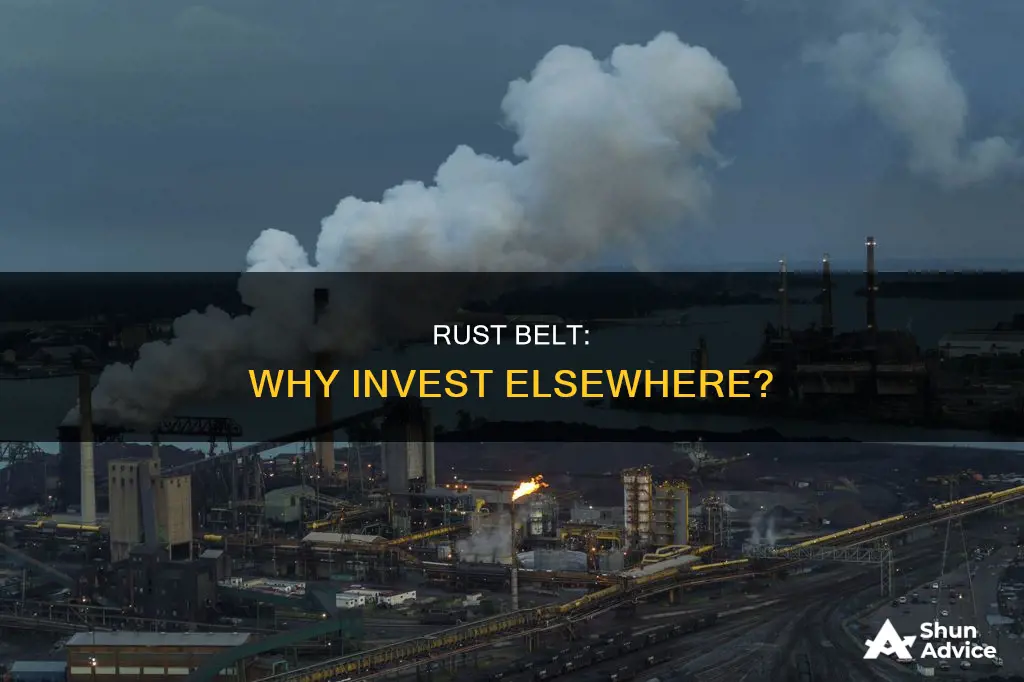
The Rust Belt is a colloquial term for the region in the US that stretches from New York through the Midwest, which was once dominated by coal, steel production, and manufacturing. The term Rust Belt refers to the impact of deindustrialization, economic decline, population loss, and urban decay. The region's manufacturing sector has been in decline since the 1950s, with companies moving jobs overseas and to the South in search of lower costs and cheaper labour. This has resulted in a large-scale exodus of the population, urban decay, and poverty. While there have been attempts to reinvent properties in the Rust Belt and attract new businesses, the region continues to struggle with the social and economic consequences of deindustrialization.
| Characteristics | Values |
|---|---|
| Population | Declining |
| Incomes | Falling |
| Unemployment | Rising |
| Wages | Dropping |
| Jobs | Outsourced or eliminated |
| Manufacturing | Declining |
| Innovation | Lack of |
| Competition | Lack of |
| Union power | High |
| Social problems | Rising |
What You'll Learn

Lack of innovation and productivity improvements
The Rust Belt's decline in the 1950s can be attributed to a lack of innovation and productivity improvements. This was due to the region's dominant industries, such as steel, tires, and automobiles, facing little to no competition, giving them little incentive to innovate or improve productivity. The lack of competition was a result of the destruction caused by World War II, which left domestic firms like U.S. Steel and General Motors with minimal foreign competition.
With enough business to go around, these firms had no reason to modernize their equipment and machinery or invest in new technologies. This lack of innovation further solidified the Rust Belt's decline when the U.S. opened trade overseas, as they were unable to keep up with the more efficient processes of updated technology.
The lack of innovation was also influenced by the presence of powerful labor unions in the Rust Belt, such as the United Steelworkers (USW) and the United Auto Workers (UAW). These unions were able to use the threat of strikes to obtain higher wages, which increased production costs for Rust-Belt firms. This created a "hold-up" problem, where firms knew that any increase in profits due to productivity improvements would have to be negotiated with the unions, making them reluctant to invest in innovation.
As a result, the Rust Belt's share of manufacturing jobs declined by about 34% between 1950 and 1980, and its share of economy-wide jobs declined by about 28% during the same period. This indicates that the region's slump was not just a result of a general decline in U.S. manufacturing but was uniquely deep and prolonged.
The lack of innovation and productivity improvements in the Rust Belt can be attributed to the lack of competitive pressure and the influence of powerful labor unions, which together disincentivized firms from investing in new technologies and improving their practices.
Classroom Tech: Investments and Innovations
You may want to see also

High labour costs
The Rust Belt is a colloquial term used to describe the geographic region stretching from New York through the Midwest that was once dominated by the coal industry, steel production, and manufacturing. The region received its name in the late 1970s after a sharp decline in industrial work left many factories abandoned and desolate, causing increased rust from exposure to the elements.
The high labour costs in the Rust Belt can be attributed to several factors, including:
- Powerful labour unions: The presence of powerful labour unions, such as the United Auto Workers and the United Steelworkers, in the Rust Belt industries ensured that there was limited labour competition. These unions were able to negotiate higher wages through frequent strikes and strike threats, increasing production costs for companies.
- Lack of competitive pressure: In the 1950s, Rust Belt firms faced minimal competition and had little incentive to innovate or expand. This lack of competition led to stagnant production and higher costs.
- Outdated equipment and machinery: Many manufacturers in the Rust Belt used expensive and outdated equipment, which contributed to higher labour costs.
- Shift to service-oriented industries: The US economy's shift towards service-oriented industries reduced the demand for labour-intensive manufacturing industries, leading to higher relative wages for manufacturing workers.
- Comparative labour costs: The Rust Belt region, particularly the northwest, tended to have higher wages compared to other regions due to the greater influence of trade unions and the availability of migrant labour in the south.
These factors contributed to the high labour costs in the Rust Belt, making it challenging for businesses to invest and compete with other regions offering lower labour costs.
Billionaires' Investment Secrets
You may want to see also

Lack of competition
The Rust Belt is a colloquial term for the geographic region stretching from New York through the Midwest that was once dominated by the coal industry, steel production, and manufacturing. The term is often used in a derogatory sense to describe parts of the country that have experienced drastic economic decline.
The Rust Belt's decline started in the 1950s when the region's dominant industries faced virtually no product or labor competition. This lack of competition meant that established companies had little incentive to innovate or expand, operating like monopolies. Industries such as steel, tires, and automobiles were dominated by a few domestic firms like U.S. Steel and General Motors (GM), which faced little foreign competition due to the destruction of World War II. As there was enough business to go around, firms felt little pressure to innovate or increase productivity.
The lack of competition in the labor market also contributed to the decline. Two of the largest and most powerful unions in the country, the United Steelworkers (USW) and the United Auto Workers (UAW), were based in the Rust Belt. These unions were able to use the threat of strikes to obtain higher wages, which increased production costs for Rust-Belt firms. This contributed to a "hold-up" problem, where firms knew that any increase in profits due to productivity improvements would have to be bargained over with the unions, making them reluctant to invest in innovation.
The lack of competition in both the output and labor markets of Rust-Belt industries can account for most of the decline in the region's share of employment from 1950 to 2000. By the time union power subsided and firms realized they had fallen behind new foreign and domestic competitors, it was too late. The region's manufacturers eventually began to innovate, but this resulted in a stabilization of employment at a significantly lower level.
The decline of the Rust Belt has important implications for policy, suggesting that vigorous competitive pressure in both product and labor markets is necessary to create incentives for firms to continuously innovate, create, and grow.
Retirement Planning: Where to Invest Your Money
You may want to see also

Unfavourable economic policies
The Rust Belt, a colloquial term for the geographic region stretching from New York through the Midwest, has been facing a decline in manufacturing and other heavy industries since the 1950s. This decline has resulted in a decrease in population, rising unemployment, and social problems. One of the main reasons for this is the unfavourable economic policies that have been in place for decades.
The Rust Belt states have had relatively unfavourable economic policies for at least 50 years. While some Rust Belt states have adopted more market-friendly policies in recent years, they are merely catching up with other states that have had these policies in place since the 1950s. This late adoption of more favourable economic policies may not be enough to reverse the decline of the region.
One example of unfavourable economic policies in the Rust Belt is the lack of right-to-work laws. Only four out of eight Rust Belt states have adopted such laws, while all the states in the Southeast, which has seen more manufacturing activity, have these laws in place. This has made it more difficult for Rust Belt states to attract new businesses and investments.
Another factor contributing to the economic decline of the Rust Belt is the lack of competition in industries such as steel, tires, and automobiles in the decades following World War II. Domestic firms like U.S. Steel and General Motors dominated these industries and faced little foreign competition due to the destruction caused by the war. With enough business to go around, these firms had little incentive to innovate or increase productivity. This lack of competition was recognised by the industries themselves, who acknowledged the negative impact of inadequate capital formation on productivity and efficiency.
In addition to the lack of competition in the output market, there was also a lack of competition in the labour market in the Rust Belt. Two of the largest and most powerful unions in the country, the United Steelworkers (USW) and the United Auto Workers (UAW), were based in the region. These unions were able to use the threat of strikes to obtain higher wages, which increased production costs for Rust Belt firms. This contributed to a "hold-up" problem, where firms were reluctant to invest in innovation because they knew that any increase in profits would have to be bargained over with the unions.
The lack of competition in both the output and labour markets has been calculated to account for most of the decline in the Rust Belt's share of employment from 1950 to 2000. By the time union power diminished and firms realised they had fallen behind competitors, it was too late to reverse the decline.
Retirement Planning: Many Left Behind
You may want to see also

Negative regional multiplier effect
The "Rust Belt" is a colloquial term for the geographic region of the US that was once dominated by the coal industry, steel production, and manufacturing. The term is often used in a derogatory sense to describe parts of the country that have experienced drastic economic decline.
The negative regional multiplier effect is a key factor in the decline of the Rust Belt. When large steel or coal plants shut down, it triggers a ripple effect throughout the local economy. As unemployment rises, there is a corresponding fall in demand for local services such as transportation, food, and entertainment. This is because many local jobs were indirectly linked to the big manufacturing employers.
With declining incomes, rising unemployment, and pessimism about future prospects, local residents often leave these towns to seek employment elsewhere. This "brain drain" of young, skilled workers further exacerbates the negative regional multiplier effect. As the population declines, there is a decrease in tax revenues, making it challenging for local governments to invest in new infrastructure and services.
The negative regional multiplier effect creates a self-reinforcing cycle of decline, where job losses lead to population out-migration, which in turn results in further job losses and economic deterioration. This spiral of decline is challenging to stop and can lead to a long-term loss of economic vitality in the region.
Young Investors: Where to Begin?
You may want to see also
Frequently asked questions
The Rust Belt, a colloquial term for the geographic region stretching from New York through the Midwest, has been associated with economic decline, population loss, and urban decay. The decline of traditional manufacturing industries in this region has resulted in social problems, such as drug use and higher crime rates, making it less attractive for investment.
The decline of the Rust Belt can be attributed to several factors, including the shift from heavy manufacturing to a service-oriented economy, globalization and free trade agreements, the rise of automation and new technologies, and the outsourcing of jobs to regions with lower labor costs.
The decline in manufacturing jobs has led to significant population loss, falling real incomes, and social problems associated with structural unemployment in the Rust Belt. Local governments have also been affected by declining tax revenues, making it challenging to invest in new infrastructure and address social issues.
Yes, there are some positive signs and initiatives. For example, Intel announced a $20 billion investment in Ohio, and there have been attempts to reinvent properties and reverse the economic decline. New types of research and development-intensive manufacturing, such as biotechnology and nanotechnology, are also emerging in the region.
Globalization and free trade agreements accelerated the decline of the Rust Belt by making it easier for firms to shift production to areas with lower labor costs. This resulted in increased imports from countries like China and Japan, reducing domestic demand for US-manufactured goods.







